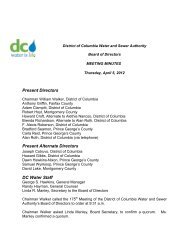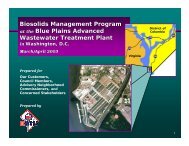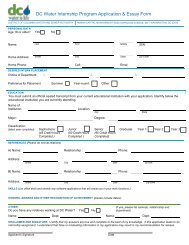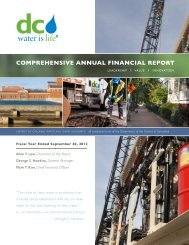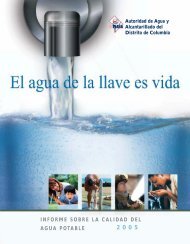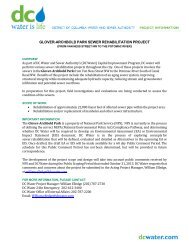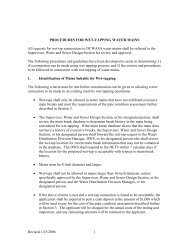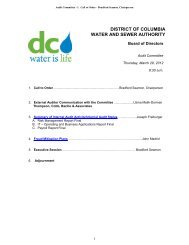FY 2020 Capital Improvement Program - DC Water
FY 2020 Capital Improvement Program - DC Water
FY 2020 Capital Improvement Program - DC Water
Create successful ePaper yourself
Turn your PDF publications into a flip-book with our unique Google optimized e-Paper software.
STORMWATER<br />
The lifetime budget for the Stormwater Service Area is $59 million, a decrease of $3 million from last year primarily due to the<br />
cancellation of certain projects in this area. Over the past few years, extensive dialogue among stormwater task force members<br />
resulted in a better definition of roles, responsibilities and funding sources for the activities required to enhance <strong>DC</strong> stormwater<br />
management. The <strong>DC</strong> Department of the Environment (DDOE) entered into agreements with various offices to provide services in<br />
support of the District’s MS4 permit in accordance with funding availability from the Enterprise Fund. <strong>DC</strong> <strong>Water</strong> provides for the<br />
maintenance and replacement of certain public facilities that convey stormwater runoff to the Anacostia and Potomac Rivers, Rock<br />
Creek, and other receiving streams within certain areas of the District of Columbia, specifically the areas of the District served by<br />
combined sewers. Various other agencies have responsibility for a variety of other stormwater activities. Discussion of other<br />
matters, such as the turnover of stormwater pumping facility maintenance and planned capital replacement of infrastructure in areas<br />
managed by the District under the MS4 permit continues. DDOE maintains the central responsibility for managing stormwater<br />
activities under the MS4 permit and has worked to coordinate with all agencies, the activities and funding mechanisms necessary to<br />
ensure full compliance.<br />
While <strong>DC</strong> <strong>Water</strong> has the Clean Rivers Project to address these issues within the combined sewer areas, <strong>DC</strong> <strong>Water</strong>’s staff continues<br />
to participate in the MS4 task force and to monitor the impact of other MS4 NPDES requirements on <strong>DC</strong> <strong>Water</strong> and its ratepayers.<br />
Significant progress has been made throughout the District. Since 2001, <strong>DC</strong> <strong>Water</strong> collected the MS4 stormwater fees on behalf of<br />
the District, and acted as the Stormwater Administrator until the creation of DDOE and the transfer of duties in early 2007. <strong>DC</strong> <strong>Water</strong><br />
continues to collect those fees on behalf of the District and transfer them to DDOE quarterly. In <strong>FY</strong> 2009, we worked closely with<br />
DDOE to share our impervious surface area database. Along with <strong>DC</strong> <strong>Water</strong>, DDOE believes that this new rate structure can help to<br />
equitably allocate costs of services provided to the cost causers and influence future behavior through education.<br />
SANITARY SEWER<br />
A majority of the sewers in the <strong>DC</strong> <strong>Water</strong> system were constructed more than one hundred years ago and are still in operation.<br />
Aging infrastructure is a national issue and can impact the condition and performance of the system. <strong>DC</strong> <strong>Water</strong> is responsible for<br />
wastewater collection and transmission in the District of Columbia, including operation and maintenance of the sanitary sewer<br />
system. <strong>DC</strong> <strong>Water</strong>’s sanitary sewer system includes approximately 600 miles of large interceptor sewers and smaller gravity<br />
collection sewers. <strong>DC</strong> <strong>Water</strong> is also responsible for sewer lateral connections from the sewer mains to the property lines of<br />
residential, government, and commercial properties. In addition, <strong>DC</strong> <strong>Water</strong> is responsible for the 50 mile long Potomac Interceptor<br />
System under an agreement with the participating jurisdictions. This provides conveyance of wastewater from areas in Virginia and<br />
Maryland to Blue Plains. The existing sanitary sewer system in the District of Columbia dates back to 1810, and includes a variety of<br />
II - 5



